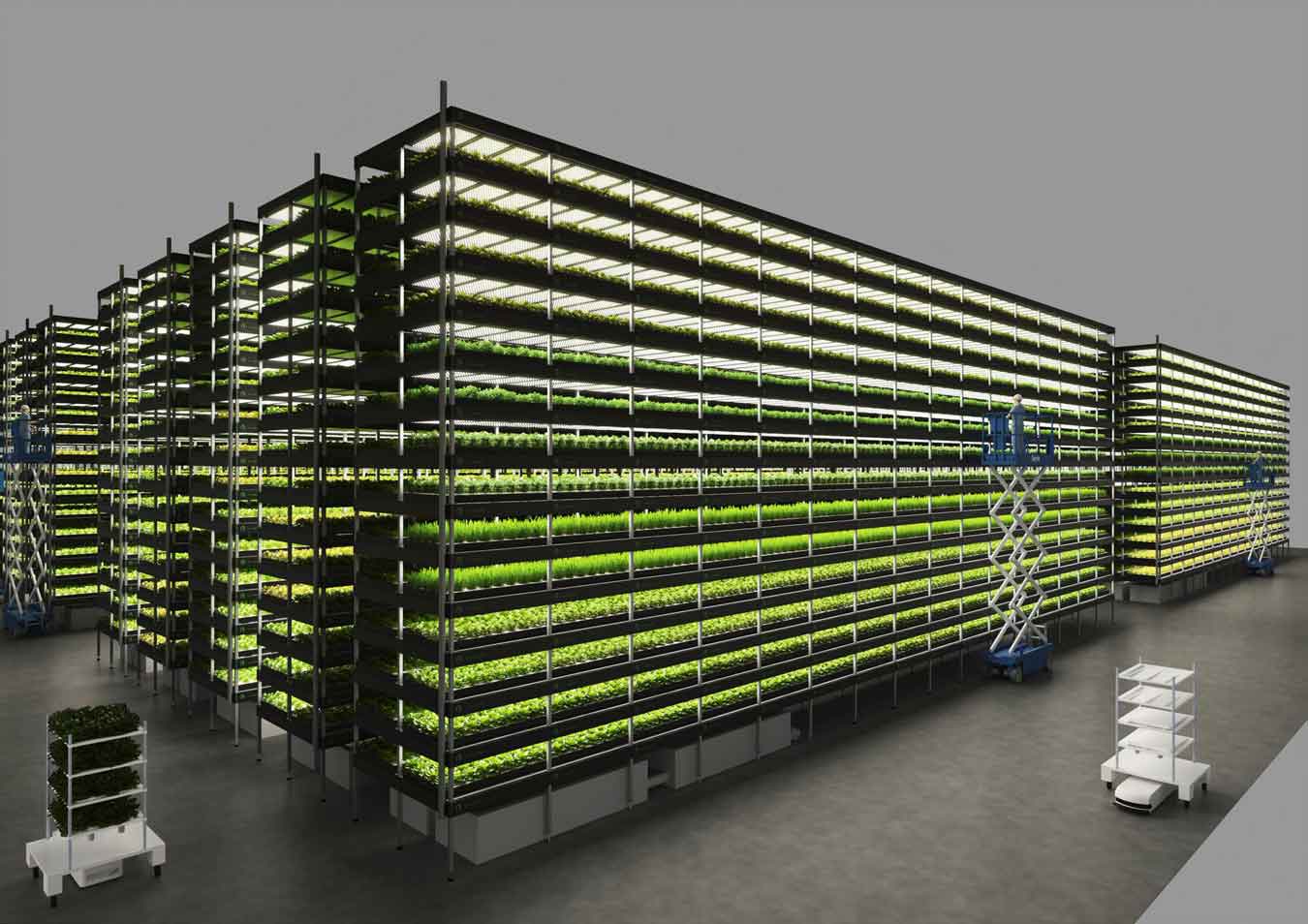Vertical Farms Reimagine Sustainable Food Systems
The global population continues to grow and climate change becomes more tangible. We know that we cannot continue expanding boundlessly over the Earth’s surface, so we are growing vertically—in all possible ways: beginning with skyscrapers, now structures for crop cultivation are taking off from the ground to elevate in the sky. Vertical Farms are here to integrate in the modern city.
Imagine, communities of lettuce and micro-greens find a home in steel structures that rise vertically throughout the city. At first, you may imagine that these buildings are like vertical forests—blooming greenery everywhere, adding romantic landmarks to the city. But as opposed to that biophilic dream, vertical farms are meant to get some work done: offer an efficient, environmentally-friendly food supply.
This kind of soil-less agriculture—that sounds contradictory in itself—are modular, self-contained compartments of greens stacked in layers in rooms which atmosphere mimics the natural environment that these greens need to grow. Vertical farms run on LED lighting, thrive on microbial fertilisers, and use hydroponic systems, all harnessed to make the harvesting more efficient in exchange of a lower use of resources and chemicals. That’s on the production level. On the distribution side, vertical agriculture would be the best friend of local food hunters, for they will erect in the inner fringes of the city, putting an end to long-distance travel.

Vertical Farm in Copenhagen
Since vertical farms would cram up in cities, over-farmed lands would be free of agricultural activity, allowing nature to sprout back again, fulfilling the popular desire to let landscapes re-wild, offering residents the possibility to see nature at its own devices. For such reasons, vertical farms have climbed up to the top of urban planning, becoming the holy grail of urbanists, environmentalists and wildlife conservation advocates, restoring hopes for a greener future.
The desire to see landscapes in their own natural state has been one of the main incentives for the startup Nordic Danish and the Taiwanese tech specialist YesHealth Group to build the Vertical Farm in Copenhagen. According to the Nordic Danish, the equivalent to 20 soccer fields are needed to supply the entire demand for greens in Denmark which, in winter, are imported mostly from Spain and Italy. With the Vertical Farm, that has launched in December last year, these travel distances would be cut down offering, in turn, fresh greens all year round. That sounds like a legit balance between self-sustained systems and healthy food supplies.
In fact, the idea of using vertical farms in an effort to build self-sustained cities and decolonise the Earth’s surface has been prompted by many architects and environmentalists who urge the radical implementation of technologies. In his speculative short film, Planet City, architect and filmmaker Liam Young draws a self-sufficient city able to host the world’s population. Young explains that the city is based on technologies that already exist, which can harness a complex of vertical farms able to supply the entire world’s population. The final outcome of restructuring our cities around efficient technologies is to occupy the minimum of the Earth’s surface—as little as 0,02%—allowing ecosystems to re-wild.
While this sounds radical but fairly a good solution to climate change and shortage in food supply, vertical farms are still at early stage and their offer is limited to greens: lettuce, micro-greens and herbs. Tech and food experts are working to make root vegetables and fruits such as berries a staple in their supply. Figuring out the right recipe to grow different kinds of vegetables—a combination between temperature, lighting, seeds and amount of water, to mention just the basics—will take some trial and error experiments. Until then, we cannot rely our food supply on these agricultural systems.
And here is where the real anti-thesis to land-less agriculture comes. Can we really mimic ecosystems capable to replace processes that belong in nature at all? While we certainly have sophisticated technologies and advanced centres of artificial intelligence, assuming that crops that organically sprout over soil can be equally harvested in artificial environments, controlled through robotic operation, is a complex task that the human mind may be underestimating amidst fantasies fuelled by technological supremacy.
Not only nature enthusiasts find this form of crop cultivation disturbing, but also research suggests that natural cycles, such as the passing of seasons, are important for the growth and health of crops. According to a research published in the journal Science, “plants grow much better when their internal clock is matched to the environment they grow in,” and that allow them to develop resilience to withstand pests and thrive healthily. Cultivations growing in artificial environments would be generally cut away from regular climate factors such as rain, wind, and sunlight variations that help crops sync to their own rhythms.
So far, eco-friendly solutions that help us alleviate space-pressed cities and over-farmed lands, and reinvent new production models are either inefficient or radical. But with growing populations, technological developments, and modern cities building layers on top of each other, shouldn’t we just take all our chances and continue moving upwards? After all, sci-arc films like Young’s are assertive in illustrating how technology can shape spaces, and how they could help us cope with much needed production and consumption paradigm shifts—no matter how radical they seem.
*All media courtesy of Nordic Harvest

+ Words: Alejandra Espinosa, Luxiders Magazine Editor
Liberal Arts graduate | Berlin-based writer
Connect with her through alejandraespinosa.site




